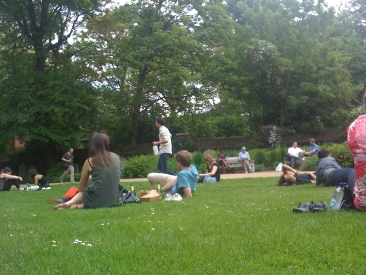
And relax…
I spoke to a wise oncologist this week, who told me that the future of cancer treatment was about quality of life, rather than quantity of life, after treatment. She said the aim now was to minimise treatment, balancing effectiveness with doing as little damage as possible to the body and its long-term future health. This was especially important in children or young people with decades of life ahead.
The art of doing less is an elegant riposte to our busy insistence on doing ‘everything we can’. Two studies in children I recently reviewed for NHS Choices showed how less can sometimes be dramatically more.
The first study demonstrated a new method of treating congenital cataracts in young children. Standard treatment was to remove all trace of the clouded lens through a hole in the lens capsule. Almost all children needed laser surgery in the months after initial treatment, because residual lens tissue grew in a chaotic way and blocked vision. In a series of pioneering experiments, surgeons in China developed a technique to remove the clouded lens as carefully as possible, through a tiny slit in the lens capsule, leaving its lining of stem cells intact. Then they waited.
The lens re-grew. Without human interference, the children’s eyes regenerated a working lens within the capsule, within about six months. No follow-up laser surgery; possibly no need for glasses to correct eyesight. A triumph for minimally-invasive surgery.
The second study is a cautionary tale. Researchers systematically reviewed studies looking at the prevalence of antibiotic resistant E coli in children’s urine infections, worldwide. It was scarily high – above 50% for the commonly-used ampicillin/amoxicillin in developed countries, approaching 100% in less developed countries. Don’t get me wrong – children with bacterial urinary tract infections need antibiotics. Untreated infections can cause serious kidney damage. But over-use of specific antibiotics, and incorrect use of any antibiotics, has led us ever closer to a post-antibiotic age.
First, as the doctors’ oath has it, do no harm.
Sources
NHS Choices: Stem cells used to repair children’s eyes from cataracts. From Lin H, Ouyang H, Zhu J, et al. Lens regeneration using endogenous stem cells with gain of visual function. Nature. Published online March 9 2016
NHS Choices: Common antibiotics for children ‘ineffective in half of cases’. From Bryce A, Hay AD, Lane IF, et al. Global prevalence of antibiotic resistance in paediatric urinary tract infections caused by Escherichia coli and association with routine use of antibiotics in primary care: systematic review and meta-analysis. BMJ. Published online March 15 2016
